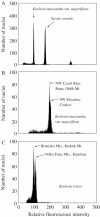Nuclear DNA content variation among Central European Koeleria taxa
- PMID: 16698888
- PMCID: PMC2803546
- DOI: 10.1093/aob/mcl077
Nuclear DNA content variation among Central European Koeleria taxa
Abstract
Background and aims: Polyploidization plays an important role in the evolution of many plant genera, including Koeleria. The knowledge of ploidy, chromosome number and genome size may enable correct taxonomic treatment when other features are insufficient as in Koeleria. Therefore, these characteristics and their variability were determined for populations of six central European Koeleria taxa.
Methods: Chromosome number analysis was performed by squashing root meristems, and ploidy and 2C nuclear DNA content were estimated by flow cytometry.
Key results: Three diploids (K. glauca, K. macrantha var. macrantha and var. pseudoglauca), one tetraploid (K. macrantha var. majoriflora), one decaploid (K. pyramidata) and one dodecaploid (K. tristis) were found. The 2C nuclear DNA content of the diploids ranged from 4.85 to 5.20 pg. The 2C DNA contents of tetraploid, decaploid and dodecaploid taxa were 9.31 pg, 22.89 pg and 29.23 pg, respectively. The DNA content of polyploids within the K. macrantha aggregate (i.e. within K. macrantha and K. pyramidata) was smaller than the expected multiple of the diploid genome (K. macrantha var. macrantha). Geography-correlated variation of DNA content was found for some taxa. Czech populations of K. macrantha var. majoriflora had a 5.06% smaller genome than the Slovak ones. An isolated eastern Slovakian population of K. tristis revealed 8.04% less DNA than populations from central Slovakia. In central and north-west Bohemia, diploid and tetraploid cytotypes of K. macrantha were sympatric; east from this region diploid populations, and towards the west tetraploid populations were dominant.
Conclusions: Remarkable intra-specific inter-population differences in nuclear DNA content were found between Bohemian and Pannonian populations of Koeleria macrantha var. majoriflora and between geographically isolated central and eastern Slovakian populations of K. tristis. These differences occur over a relatively small geographical scale.
Figures

Similar articles
-
Genome size variation in Central European species of Cirsium (Compositae) and their natural hybrids.Ann Bot. 2004 Sep;94(3):353-63. doi: 10.1093/aob/mch151. Epub 2004 Aug 3. Ann Bot. 2004. PMID: 15292040 Free PMC article.
-
Cytogeography and genome size variation in the Claytonia perfoliata (Portulacaceae) polyploid complex.Ann Bot. 2012 Nov;110(6):1195-203. doi: 10.1093/aob/mcs187. Epub 2012 Sep 7. Ann Bot. 2012. PMID: 22962302 Free PMC article.
-
Evolutionary and Taxonomic Implications of Variation in Nuclear Genome Size: Lesson from the Grass Genus Anthoxanthum (Poaceae).PLoS One. 2015 Jul 24;10(7):e0133748. doi: 10.1371/journal.pone.0133748. eCollection 2015. PLoS One. 2015. PMID: 26207824 Free PMC article.
-
Distribution and diversity of cytotypes in Dianthus broteri as evidenced by genome size variations.Ann Bot. 2009 Oct;104(5):965-73. doi: 10.1093/aob/mcp182. Epub 2009 Jul 25. Ann Bot. 2009. PMID: 19633312 Free PMC article.
-
Role of adaptive and non-adaptive mechanisms forming complex patterns of genome size variation in six cytotypes of polyploid Allium oleraceum (Amaryllidaceae) on a continental scale.Ann Bot. 2013 Mar;111(3):419-31. doi: 10.1093/aob/mcs297. Epub 2013 Jan 24. Ann Bot. 2013. PMID: 23348752 Free PMC article.
Cited by
-
Retroelement insertional polymorphisms, diversity and phylogeography within diploid, D-genome Aegilops tauschii (Triticeae, Poaceae) sub-taxa in Iran.Ann Bot. 2008 Apr;101(6):855-61. doi: 10.1093/aob/mcn042. Ann Bot. 2008. PMID: 18411258 Free PMC article.
-
Ecological differentiation, speciation, and rarity: How do they match in Tephroseris longifolia agg. (Asteraceae)?Ecol Evol. 2018 Jan 31;8(5):2453-2470. doi: 10.1002/ece3.3770. eCollection 2018 Mar. Ecol Evol. 2018. PMID: 29531667 Free PMC article.
-
Cytotype diversity and genome size variation in eastern Asian polyploid Cardamine (Brassicaceae) species.Ann Bot. 2010 Feb;105(2):249-64. doi: 10.1093/aob/mcp282. Epub 2009 Dec 10. Ann Bot. 2010. PMID: 20007978 Free PMC article.
-
Cytotype distribution at a diploid-hexaploid contact zone in Aster amellus (Asteraceae).Ann Bot. 2012 Oct;110(5):1047-55. doi: 10.1093/aob/mcs177. Epub 2012 Aug 10. Ann Bot. 2012. PMID: 22887024 Free PMC article.
-
Intraspecific variations in cardamom (Elettaria cardamomum Maton): assessment of genomic diversity by flow cytometry, cytological studies and ISSR analysis.Springerplus. 2016 Sep 13;5(1):1560. doi: 10.1186/s40064-016-3226-x. eCollection 2016. Springerplus. 2016. PMID: 27652133 Free PMC article.
References
-
- Arnow LA. 1994. Koeleria macrantha and K. pyramidata (Poaceae): nomenclatural problems and biological distinctions. Systematic Botany 19: 6–20.
-
- Auckland LD, Johnston JS, Price HJ, Brigwater FE. 2001. Stability of nuclear DNA content among divergent and isolated populations of Fraser fir. Canadian Journal of Botany 79: 1375–1378.
-
- Barow M, Meister A. 2002. Lack of correlation between AT frequency and genome size in higher plants and the effect of nonrandomness of base sequences on dye binding. Cytometry 47: 1–7. - PubMed
-
- Bennett MD, Leitch IJ. 2003. Angiosperm DNA C-values database (release 4·0, Jan. 2003) http://www.rbgkew.org.uk/cval/homepage.html

